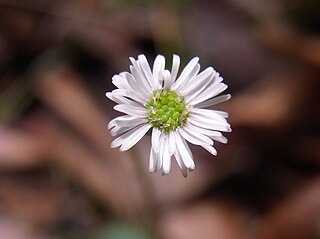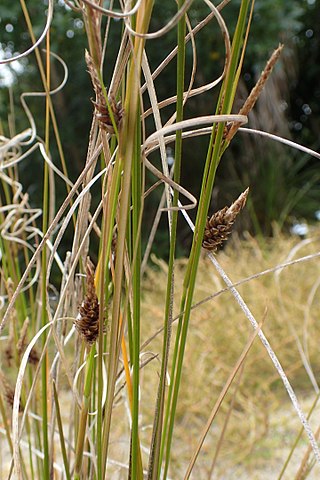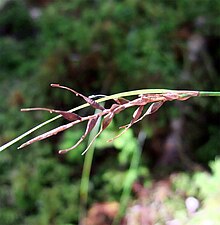
The Cyperaceae are a family of graminoid (grass-like), monocotyledonous flowering plants known as sedges. The family is large, with some 5,500 known species described in about 90 genera, the largest being the "true sedges" genus Carex with over 2,000 species.

Lepidosperma is a genus of flowering plant of the family Cyperaceae. Most of the species are endemic to Australia, with others native to southern China, southeast Asia, New Guinea, New Caledonia and New Zealand.

Gahnia is a genus of sedges native to China, Southeast Asia, New Guinea, Australia, New Zealand and a number of Pacific Islands. The common name is due to the toothed margins. It often forms tussocks.

Lagenophora is a genus of flowering plants in the family Asteraceae. Species occur in South-east Asia, Australia, New Zealand, as well as Central and South America.

Carex sect. Spirostachyae is a section of the genus Carex, containing 38 species of sedge. Species in Carex sect. Spirostachyae share a suite of features, including the short internodes of the primary rhizomes, the presence of an antiligule, the leaf-like, sheathing bract at the base of the inflorescence, the presence of three stigmas in female flowers, and the shape of the seeds.

Uncinia uncinata, the Hawai'i birdcatching sedge, hook grass, hook sedge, bastard grass, kamu or matau-a-maui, is a species of flowering plant in the sedge family, Cyperaceae.

Carex subg. Carex is a subgenus of the sedge genus Carex. It is the largest of the four traditionally recognised subgenera, containing around 1400 of the 2000 species in the genus. Its members are characterised by the presence of one or more exclusively male (staminate) terminal spikes, quite dissimilar in appearance from the lateral female (pistillate) spikes below. In most species, the female flowers have three stigmas, but a few species, including Carex nigra, have female flowers with only two stigmas.

Carex archeri, known as Archer's sedge, is a species of sedge in the genus Carex, endemic to south-eastern Australia.
Carex acaulis, known as the small dusky sedge, is a species of sedge in the genus Carex native to the Falkland Islands and southern Argentina.

Carex banksii is a species of flowering plant in the sedge family, Cyperaceae. Carex banksii is native to South America and was first formally named by Francis Boott in 1839.

Carex capillacea, common name yellowleaf sedge in Tasmania, is a species of sedge found in Assam, the far east of Russia, New Guinea, south east Australia, New Zealand, Malesia, China, Japan and India.
Carex purdiei is a tussock-forming species of perennial sedge in the family Cyperaceae. It is native to southern parts of Central America and northern parts of South America.

Carex fascicularis, commonly known as tassel sedge, is a species of sedge of the family Cyperaceae that is native to Australia, New Zealand and New Guinea.

Carex erebus is a member of the sedge family and is found on the Antarctic Islands of Australia and New Zealand.

Carex tristachya, called the shiny-spike sedge, is a species of flowering plant in the genus Carex, native to south-central and southeast China, Korea, Japan, the Ryukyus, the Philippines, Borneo, and New Guinea. Its seeds are dispersed by ants.

Carex gaudichaudiana, also known as fen sedge, is a tussock-forming species of perennial sedge in the family Cyperaceae. It is native to parts of Australia and New Zealand.

Carex litorosa, commonly known as sea sedge, is a tussock-forming species of perennial sedge in the family Cyperaceae. It is native to New Zealand.
Carex interrupta is a tussock-forming species of perennial sedge in the family Cyperaceae. It is native to south eastern parts of Canada and north eastern parts of the United States.















